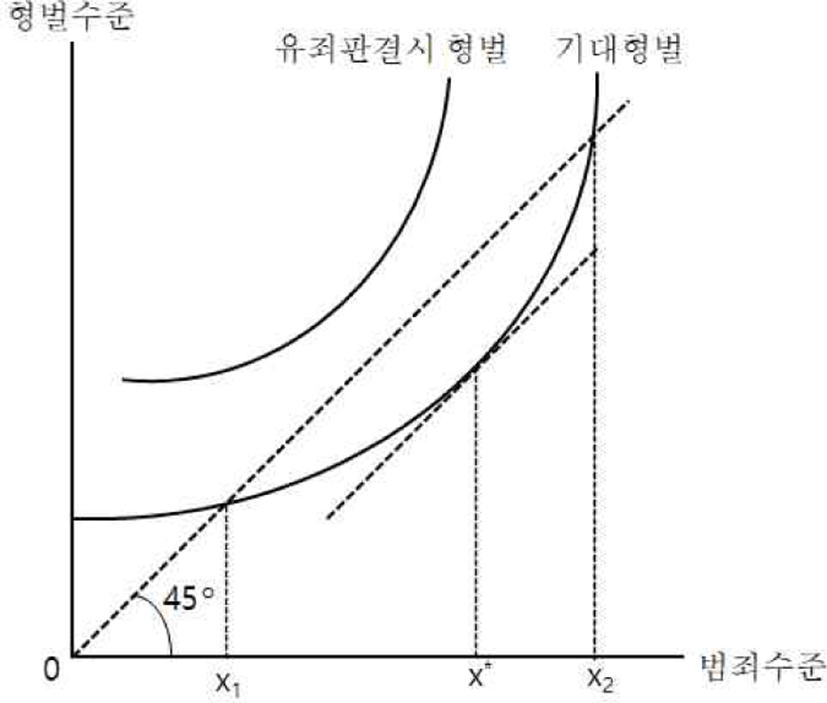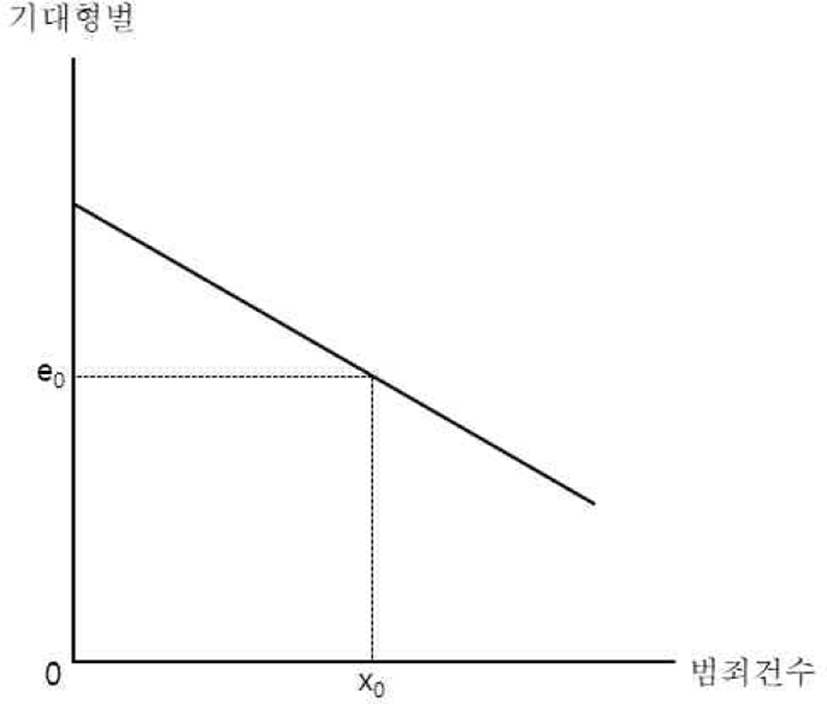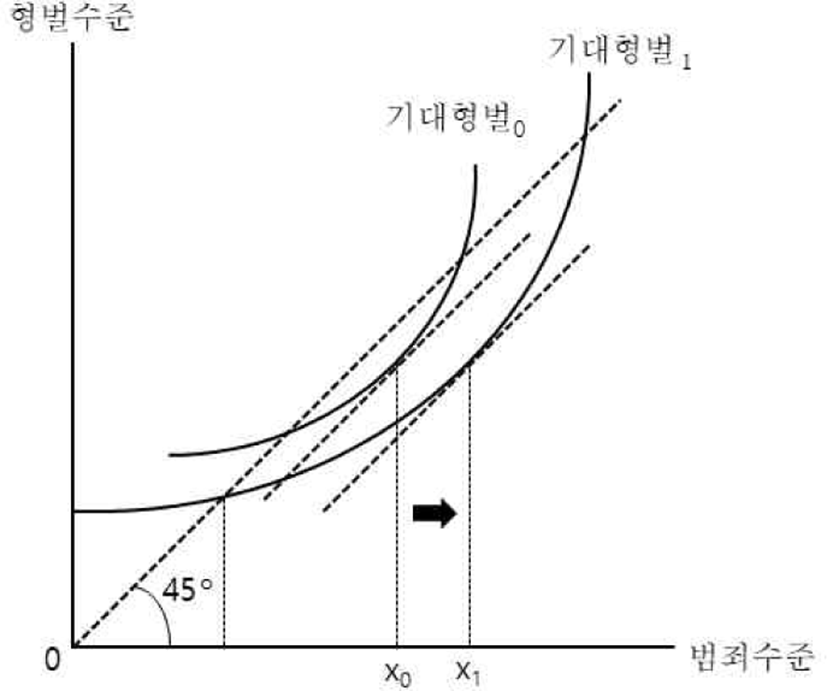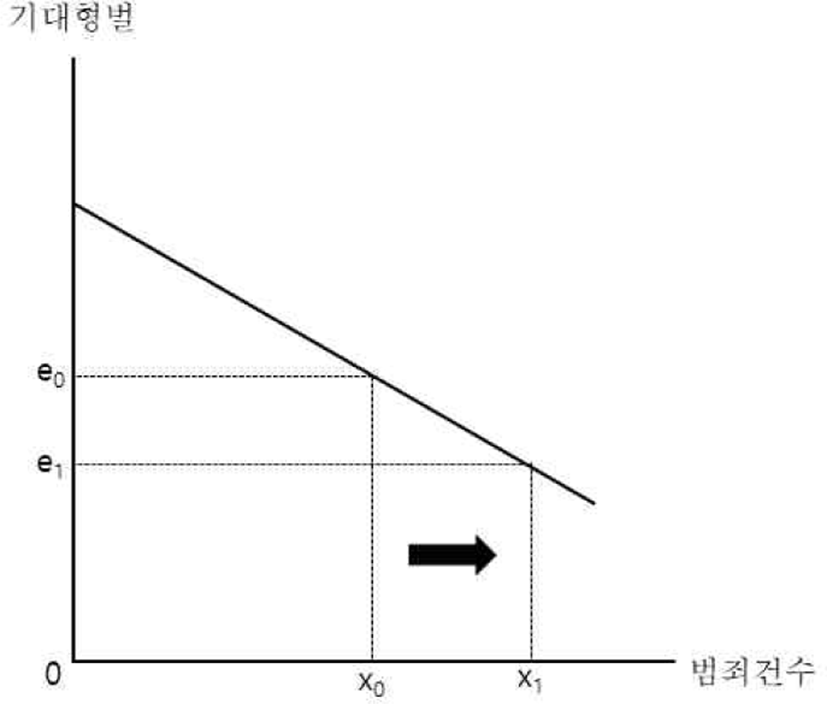Ⅰ. 서론
임시 국제형사재판소 체제에서 국제형사재판소 체제로 전환이 이루어지면서, 국제형사법상 개인형사책임 원칙에 대한 접근방식에 변화가 있었다. 특히, 정범과 공범간의 구분이 명확해지고, 정범책임에 비해 공범책임에 더 낮은 수준의 형사책임을 부과하는 방향으로 국제형사법이 발전하였다.1) 이러한 국제형사법의 발전은 개인의 형사책임 유형간 체계적인 법리를 정립하고, 개인의 형사책임 원칙과의 부합성이 강화된다는 측면에서 바람직하다고 평가받고 있다. 하지만, 이러한 개인형사책임 원칙의 변화가, 국제법상 범죄의 억지라는 실질적 측면에서도 바람직한지에 대해서는 분석이 필요하다. 국제형사재판소 규정 서문이 명시(“이러한 범죄를 범한 자들이 처벌받지 않는 상태를 종식시키고, 이를 통하여 그러한 범죄의 예방에 기여하기로 결정하며 - Determined to put an end to impunity for the perpetrators of these crimes and thus to contribute to the prevention of such crimes")하고 있는 바와 같이, 국제형사법의 중요한 목표 중에 하나는 국제범죄의 억지이기 때문이다.
국제형사재판소에서 이루어진 개인형사책임 원칙 전환에 대해 그간 법률적 측면에서는 다양한 비판과 검토가 이루어졌으나, 국제범죄의 최소화라는 국제형사법 목적 달성에 있어 이러한 개인형사책임 원칙의 전환이 실제 어떠한 법정책적 의미를 갖는지에 대한 분석은 거의 이루어지지 않았다. 이에 이 논문은 법경제학적 방법론을 활용하여 개인형사책임 원칙의 전환이라는 국제형사법의 변화가 어떠한 법정책적 함의를 갖는지 분석하였다. 먼저, 임시 국제형사재판소 체제에서 국제형사재판소 체제로 전환되면서 이루어진 개인형사책임 원칙의 변화를 살펴보았으며, 이러한 개인형사책임 원칙의 변화가 실제 형량선고에 있어 갖는 영향을 국제형사재판소와 국제형사재판소의 통계를 통해 살펴보았다. 아울러, 범죄-형벌 분석모형을 활용하여 국제형사법상 개인형사책임 원칙의 변화가 국제법상 범죄수준, 총범죄건수 증감에 있어 어떠한 법정책적 함의를 내재하고 있는지를 검토하였다.
Ⅱ. 국제형사재판소 체제에서 정범과 공범의 구분
ICTY 규정(Stature of the International Criminal Tribunal for the Former Yugoslavia) 제7조제1항은 개인의 형사책임 유형을 병렬적으로 규정하고 있다.2) 특히, 실행(commission) 이외의 형사책임 유형(기획, 선동, 명령)을 실행보다 우선하여 규정하고 있으며, 모든 형사책임 유형에 원칙적으로 동일한 법정형을 적용한다는 특징을 갖는다.3) 개인의 형사책임 유형이 병렬적이라는 것은 ICTY 규정이 개인의 형사책임 유형과 형량간의 관계에 대한 원칙을 규정하고 있지 않다는 점에서도 잘 나타난다.4) 이에 따라, 임시 국제형사재판소는 ICTY 규정 제7조제1항을 해석·적용함에 있어 정범과 공범의 개념을 구분하기는 하였으나, 개인의 형사책임은 포괄적으로 부과하였다.5) 예를 들면, Tadić 사건에서 임시 국제형사재판소 상소심재판부는 방조범에게 공범책임을 부과6)하였으나, 양형 과정에서는 형사책임 유형을 형량에 고려하지 않았다.7)
한편, 임시 국제형사재판소는 직접 범죄를 실행하지는 않지만 배후에서 범죄의 실행에 중요한 역할을 수행하는 자에 대해 공범이 아닌 정범 책임을 부과할 수 있는 JCE 이론을 도입하여, 정범의 개념적 외연을 확장하였다.8)Tadić 사건의 1심재판부는 ICTY 규정 제7조제1항에 명시되지 않은 JCE 이론을 토대로, 공동목적(common purpose)을 가지고 범죄행위에 가담한 자들이 실행한 행위도 ICTY 규정 제7조제1항상 실행(commission)에 해당한다고 판시하였다.9) 아울러 Lubanga 사건에서 전심재판부가 지적한 바와 같이, 주관적 접근방법에 근거한 JCE 이론은 범죄의 실행에 기여한 정도와 무관하게 공통의 의도를 가지고 범죄에 기여한 자에게 정범책임을 부과할 수 있는 근거가 되었다.10) 이러한 JCE 이론은 개인의 형사책임의 인정범위를 더 넓게 설정함으로서, 집단이 저지르는 범죄와 관련하여 개인의 형사책임 추궁을 용이하게 하였다.11) 특히, 직접 범죄를 범한 자와 지도자인 상급자가 동일한 JCE를 구성하고 있다면, 지도자인 상급자도 당해 범죄를 실행한 것으로 간주하여 ICTY 규정 제7조제1항을 근거로 처벌할 수 있게 하는 법리적 기반을 제공하였다.12)Brđanin 사건의 상소심재판부도 JCE 이론은 ICTY 관할범죄를 직접 실행하지 않은 자에게 개인 형사책임을 추궁하기 위한 것이라는 점을 명확하게 지적하였다.13)
그러나, 이러한 JCE 이론에 대해 많은 비판도 이루어졌다. 첫째, JCE 이론은 정범책임과 공범책임을 구분하지 않고 모두 정범책임을 부과14)하며, 다양한 범죄기여 수준과 그에 대한 귀책간 차별화가 이루어지지 않는다는 지적이 존재하였다.15) 둘째, JCE 요건이 충족되는 경우, 피고인은 자신이 범죄에 기여한 부분에 대해서만 형사책임을 지는 것이 아니라, 다른 JCE 구성원에 의해 실행된 범죄와 당해 범죄실행에 따라 객관적으로 예견가능한(objectively foreseeable) 결과에 대해서도 형사책임16)을 지게 되며, 이에 따라 개인의 형사책임 범위가 불합리하게 확대될 수 있다는 비판이 존재하였다.17) 특히, JCE 이론 3유형의 경우 형사책임 귀속이 무과실책임 형태로 이루어지거나 개인의 형사책임 원칙에 반하는 형사법상 연대책임을 구성할 수 있다는 지적이 존재하였다.18) 셋째, JCE 이론은 형사법상 형벌의 의의를 침해하고 있다는 점에서 죄형법정주의(principle of legality)에 위배되는 요소를 가지고 있다는 비판이 제기되었다.19)
국제형사재판소 규정 제25조제3항은 “commit”이라는 요건 충족여부를 기준으로 정범과 공범을 묵시적으로 구분하였다.20) 즉, 국제형사재판소 규정 제25조제3항(a)호는 범죄를 범한 것(committing a crime)에 대한 정범책임을, 제25조제3항(b)호내지 (d)호는 범죄의 실행에 기여한 것(contributing to the commission of a crime)에 대한 공범책임을 규정하고 있다.21) 이러한 공범책임은 (b)호상 야기유형, (c)호상 조장유형, (d)호상 기여유형으로 대별할 수 있다.22)
이러한 규정을 토대로, 국제형사재판소는 범행지배이론을 도입하여 기존 임시 국제형사재판소가 채택해온 개인의 형사책임 이론과 다른 접근 방식을 채택하였다.23)Lubanga 사건에서 국제형사재판소 1심재판부는 정범의 경우 범죄의 실행을 통제·지배(control or mastermind)하는 자인 반면, 공범은 범죄의 실행에 있어 부차적 역할만하는 자라고 판시하며, 범행의 통제·지배를 기준으로 정범과 공범을 구분24)하였으며, 이후 상소심재판부도 이러한 입장을 확인하고, 더 나아가 정범에 더 과중한 형사책임이 부과되어야 한다는 입장을 표명하였다.25) 국제형사재판소가 채택한 차등화 모델(differentiated model)의 핵심인 통제 기준(control criterion)은, 제25조제3항(a)호에 규정된 정범에게 다른 형사책임 유형에 비해 가장 높은 수준의 형사책임을 부과하는 것을 정당화한다.26) 아울러, 범행지배이론은 범행통제·지배 존부를 기준으로 정범과 공범의 구분하며, 범행통제·지배가 존재하는 경우 공범책임에 비해 더 엄격하게 정범책임을 추궁할 수 있는 근거를 제공한다.27) 특히, 범행지배이론을 토대로 한 공범이론은 범죄 실행 담당여부를 기준으로 정범과 공범을 구분하는 공범의 종속성 원리를 내재28)하고 있으며, 공범의 가벌성은 정범의 실행에 종속되게 된다.29)
이러한 범행지배이론에 대해 다양한 측면에서 비판이 이루어졌다. 첫째, 국제형사재판소의 범행지배이론은 정범성 판단기준을 지배(control) 개념에만 과도하게 의존한다는 지적이 존재한다.30) 둘째, 국제형사재판소 규정 제25조제3항 성안과정을 고려할 때 동조가 단일한 이론적 근거에 기반하고 있지 않은 만큼, (b)호내지 (d)호상 형사책임이 (a)호상 형사책임보다 더 낮다고 인식하는 것은 타당하지 않다는 비판도 이루어지고 있다.31) 공범책임과 정범책임간의 구분은 단지 공범책임이 정범책임에 종속 또는 파생(derivative)된 다는 것만을 의미하며, 공범책임에 더 낮은 형사책임을 부과해야 한다는 규칙이나 이론은 부재하다는 것이다.32) 또한, 국제형사재판소 절차 및 증거규칙(Rules of Procedure and Evidence) 제145조제1항(c)호도 가담의 정도(degree of participation)를 형량 선고시 하나의 고려요소로만 규정33)하고 있으며, 형량 선고에 있어 공범책임에 대한 필요적 감경을 명시적으로 규율하고 있지 않은 만큼 국제형사재판소 규정 제25조제3항에 규정된 개인의 형사책임 유형간 위계를 설정하는 것이 타당하지 않다고 지적한다.
국제형사법은 정범과 공범을 명확하게 구분하고, 이러한 구분을 토대로 정범책임과 공범책임간 차등을 두는 방향으로 발전해왔다. 특히, 정범과 공범간의 명확한 구분을 통해 형사책임 유형간 위계를 수립함으로서, 범죄자 처벌, 형량 선고에 있어 중대한 영향을 미칠 수 있는 근거가 되었다.34) 즉, 정범과 공범은 도덕적 비난가능성 측면에서 뿐만 아니라, 실제 형량 선고에 있어서도 더 중요한 의미를 갖게 된 것이다.35)
임시 국제형사재판소는 정범과 공범을 명시적으로 구분하지는 않았으나, 판례는 ICTY 규정 제7조제1항에 규정된 개인의 형사책임 유형간 경중을 나누기도 하였다.36)Bagosora et al. 사건의 1심재판부는 당해 범죄를 기획(planned)하거나 명령(ordered)한 자에게 통상 가장 높은 수준의 형량을 부과해야한다는 입장을 표명하였다.37) 아울러, Simić et al. 사건에서 ICTY 상소심재판부는 방조(aiding and abetting)는 명령(ordering), 실행(committing), JCE 참여(participating in a JCE)에 비해 낮은 형사책임이 부과되며, 형량 선고에 있어서도 이러한 점이 반영되어야 한다고 판시38)하였으며, Tadić 사건의 ICTY 상소심재판부도 방조와 JCE 참여를 명시적으로 구분하면서, JCE 참여에 더 큰 형사책임이 부과된다는 입장을 표명하기도 하였다.39) 그러나, 이는 ICTY 규정 제7조제1항에 규정된 형사책임 유형간 명확한 위계를 수립한 것은 아니었으며, Martić 사건에서 Schomburg 판사가 개별의견을 통해 지적한 바와 같이, 임시 국제형사재판소는 형량 선고시 형사책임 유형보다 실제 범죄에 기여한 정도(the individual contribution of an accused)를 더 중요하게 고려하였다.40)
국제형사재판소는 국제형사재판소 규정 제25조제3항이 형사책임 유형에 따른 차등적인 처벌을 명시적으로 규정하고 있지 않으나41), 형사책임 유형별로 형사책임 경중을 구분하는 모델을 도입하였다.42)Lubanga 사건에서 상소심재판부는 국제형사재판소 규정 제25조제3항이 정범책임과 공범책임간 위계를 설정하였으며, 이러한 구분은 형사책임 유형간 비난가능성(blameworthiness) 차이를 고려할 때 중요하다고 강조하였다.43) 이는 국제범죄의 집단적 특징을 고려하여, 개인의 형사책임 정도를 판단함에 있어 형사책임 유형을 상당한 비중을 가지고 고려해야 한다는 입장을 전제하고 있는 것이다.44) 이처럼 국제형사재판소는 국제형사재판소 규정 제25조제3항을 해석함에 있어 차등화 모델(differentiated model)을 토대로 형사책임 유형간 우선순위와 체계성을 확립하였다.45)
다만, 정범과 공범 구분시 JCE 이론 또는 범행지배이론중 어떠한 기준을 적용해야 하는지에 대해서는 여전히 논란이 존재하고 있으며46), 형량 선고에 있어서도 정범책임과 공범책임간 차등을 두는 것이 타당한지에 대해 일관된 입장이 정립된 것은 아니다.47) 특히, 정범책임과 비교할 때 공범책임에 반드시 더 낮은 형사책임을 부과하는 것에 대한 의견합일이 이루어지지 않은 만큼, 국제형사법상 개인형사책임 발전방향이 타당한지를 법경제학적 분석을 통해 살펴볼 필요가 있다.
Ⅲ. 개인형사책임에 대한 법경제학적 분석
임시 국제형사재판소와는 달리 국제형사재판소가 국제형사재판소 규정 제25조제3항을 토대로 정범과 공범을 명확하게 구분하는 입장으로 변화한 것에 대한 법경제학적 분석을 진행하기 위해, 임시 국제형사재판소와 국제형사재판소에서 형사책임 유형별로 형량을 어느 정도 수준으로 부과하였는지를 실증적으로 살펴볼 필요가 있다. 물론, 각 사건별 개별성·특수성, 최종적으로 형량이 확정된 국제형사재판소 판례수의 제한 등으로 인해 실증분석상의 한계는 존재하나, 적어도 정범책임에서 공범책임으로 변화하였을 때 기대형벌의 변화가 존재하는지 여부를 살펴보고, 이를 토대로 범죄-형벌 분석모형에 따른 법경제학적 분석을 진행할 수 있을 것이다.
임시 국제형사재판소와 국제형사재판소 형량부과 통계분석의 일관성 유지를 위해, ①2개 이상의 형사책임 유형에 대해 유죄판결을 받은 경우에는 각각의 형사책임 유형 통계에 모두 산입하였으며48), ②형량 부과에 영향을 미치는 사건별 사실관계 차이, 가·감경 사유 등을 고려할 수 없는 점을 반영하여 형량범위를 명기하였고, ③종신형 등 이상치(outlier)로 인한 통계 왜곡 문제를 최소화하기 위해 평균값이 아닌 중위값을 산정하였다.49)
ICTY의 형량 부과 통계를 살펴보면, 다음과 같은 특징이 나타난다. 첫째, ICTY규정 제7조제1항에 규정된 형사책임 유형간 형량 범위에 있어 큰 차이가 나타나지 않는다. 이는 ICTY가 각각의 형사책임 유형에 대해 형사책임 경중을 구분하지 않았다는 것을 간접적으로 보여준다. 둘째, 국제범죄 실행을 기획, 선동, 명령한 지휘자에게 상대적으로 높은 형량이 부과되었다. 기획범(Planners), 선동범(Instigators), 명령범(Order-givers)에게 부과된 형량의 중위값이 20년 이상인 반면, 범죄실행자(Perpetrators), 공동범죄집단(JCE) 참여자, 방조범(Aiders)에게 부과된 형량의 중위값은 20년 이하로 나타났다. ICTY가 간접정범 또는 교사범과 유사한 기획범, 선동범, 명령범에게 높은 형량을 부과한 반면 정범에 해당하는 범죄실행자, 공동범죄집단 참여자에게는 상대적으로 낮은 형량을 부과한 점, 방조범에 대해 정범에 해당하는 범죄실행자, 공동범죄집단 참여자와 유사한 수준의 형량을 부과한 점을 고려할 때 ICTY는 정범책임과 공범책임간 경중을 구분하지 않았다는 것을 간접적으로 보여준다.
| 기획범 (Planners) | 선동범 (Instigators) | 명령범 (Order-givers) | 범죄실행자 (Perpetrators) | 공동범죄집단 (JCE) | 방조범 (Aiders) | |
|---|---|---|---|---|---|---|
| 형량 범위 | 25년 | 7년-30년 | 7년-종신형 | 5년-종신형 | 6년-40년 | 6년-35년 |
| 중위값 | 25년 | 25년 | 22.5년 | 18년 | 17년 | 15년 |
ICTR의 형량 부과 통계를 살펴보면, ICTY와 마찬가지로 ICTR에서도 형사책임 유형간 형량 범위에 있어 큰 차이가 나타나지 않는다. 이는 ICTY와 마찬가지로 ICTR도 각각의 형사책임 유형에 대해 형사책임 경중을 구분하지 않았다는 것을 간접적으로 보여주는 것이다.52)
| 기획범 (Planners) | 선동범 (Instigators) | 명령범 (Order-givers) | 범죄실행자 (Perpetrators) | 공동범죄집단 (JCE) | 방조범 (Aiders) | |
|---|---|---|---|---|---|---|
| 형량 범위 | 6년-종신형 | 6년-종신형 | 6년-종신형 | 12년-종신형 | 25년 | 6년-종신형 |
| 중위값 | 32년 | 50년 | 55년 | 50년 | 25년 | 45년 |
국제형사재판소 형량 부과 통계는 최종적으로 형량이 결정된 사건을 분석하여 도출하였다. 즉, Mahdi 사건, Katanga 사건, Lubanga 사건, Ntaganda 사건을 토대로 국제형사재판소 규정 제25조제3항 각 호별 형량 부과 수준을 살펴보았다. 국제형사재판소 형량 부과 통계를 검토해보면, 국제형사재판소 규정 제25조제3항(a)호상 정범책임과 제25조제3항(d)호상 공범책임간 형량 범위에 있어 유의미한 차이가 존재함을 알 수 있다. 이러한 차이는 다음과 같은 시사점을 갖는다. 첫째, 국제형사재판소 규정 제25조제3항(a)호상 정범책임과 제25조제3항(d)호상 공범책임간 형량 범위 차이는 국제형사재판소가 공범의 종속성 원리를 고려하고 있다는 것을 간접적으로 보여준다. 이러한 공범의 종속성 원리를 연장적용하면 명령범, 권유범, 유인범에 대한 개인의 형사책임을 규정하고 있는 제25조제3항(b)호와 방조범, 교사범에 대한 개인의 형사책임을 규정하고 있는 제25조제3항(c)호에 대해서도 낮은 형량이 선고될 수 있음을 시사한다. Mahdi 사건에서 국제형사재판소 1심재판부(Trial Chamber)는 국제형사재판소 규정 제25조제3항(a)호에 규정된 공동범죄실행(co-perpetration)과 함께, 국제형사재판소 규정 제25조제3항(b)호내지 (d)호에 해당하는 형사책임이 성립함을 확인하였다.54) 하지만, 국제형사재판소 규정 제25조제3항(a)호에 규정된 정범책임이 성립하는 경우 국제형사재판소 규정 제25조제3항(b)호내지 (d)호에 규정된 공범책임을 검토할 필요가 없다고 지적(“[G]iven that the Chamber has decided that all the elements of co-perpetration are met, there is no need to make any further findings on the accessorial liability alternatives.”)55)하며, 국제형사재판소 규정 제25조제3항(a)호상 정범책임에 비해 제25조제3항(b)호내지 (d)호상 공범책임에 더 낮은 형량이 선고될 수 있다는 점을 간접적으로 판시하였다. 또한, Bemba et al. 사건의 경우 정범책임과 공범책임 각각에 대해 형량을 산정하였으며, 국제형사재판소 규정 제78조제3항을 고려하여 가장 높은 형량이 부과된 정범책임을 기준으로 최종적인 형량을 결정한 바 있다.56) 물론, 아직 국제형사재판소 규정 제25조제3항(b)호내지 (c)호에 대한 형량 부과 통계가 부재한 만큼, 실제로 공범책임에 비해 정범책임에 더 무거운 형량이 선고되는지는 판례의 축적을 통해 확인할 필요가 있다. 둘째, 국제형사재판소 규정 제25조제3항(a)호상 정범책임과 제25조제3항(d)호상 공범책임간 존재하는 유의미한 형량 범위 차이는 국제형사재판소 규정 제25조제3항(a)호상 정범책임과 제25조제3항(d)호상 공범책임간 형사책임 및 형량 부과에 있어 위계가 존재한다는 것을 시사한다. 다만, 국제형사재판소 규정 제25조제3항(b)호내지 (c)호에 대한 형량 부과 통계가 존재하지 않는 만큼, 향후 판례의 축적을 통해 국제형사재판소 규정 제25조제3항 각 호간 위계가 명확하게 나타나는지 확인할 필요가 있다. 아울러, Lubanga 사건 1심재판부가 국제형사재판소 규정 제25조제3항 (d)호는 (b)호와 (c)호를 통해 특정될 수 없는 잔여 공범책임 유형(residual form of accessory liability)을 규정하고 있다고 판시57)한 바와 같이, 국제형사재판소 규정 제25조제3항에 규정된 개인의 형사책임 유형중 제25조제3항(d)호에 가장 낮은 수준의 형사책임이 부과된다는 점을 고려58)할 때, 형량 통계에 있어서도 이러한 판례의 태도가 실제 반영되는지도 확인할 필요가 있다.
| 제25조제3항(a)호 | 제25조제3항(b)호 | 제25조제3항(c)호 | 제25조제3항(d)호 | |
|---|---|---|---|---|
| 형량 범위 | 8-30년 | - | - | 10년-12년 |
| 중위값 | 14년 | - | - | 12년 |
이러한 국제형사재판소 형량 부과 통계분석 결과는 국제형사재판소 규정 제25조제3항(d)호에 해당하는 공범책임에 대해서는 범죄에 대한 처벌 수준이 기존 임시 국제형사재판소에 비해 낮아지고 있음을 보여준다. 이는 정범에 대해 공범보다 더 높은 수준의 형사책임이 부과된다는 국제형사법상 개인형사책임 원칙의 발전방향이, 적어도 국제형사재판소 규정 제25조제3항(d)호에 해당하는 공범책임에 대해서는 실제 형량선고에 있어서도 반영되고 있다는 점을 시사한다. 다만, 국제형사재판소 규정 제25조제3항(b)호내지 (c)호에 해당하는 여타 공범책임에 대해서는 Mahdi 사건에서 확인된 국제형사재판소의 태도가 실제 형량 통계에서도 나타나는지 향후 판례를 축적을 통해 실증적으로 살펴볼 필요가 있다.
이와는 별론으로, 국제형사재판소 규정 제25조제3항(a)호에 규정된 정범책임간 형량 부과에 차이가 존재하는지 부수적으로 살펴볼 필요가 있다. Mahdi 사건의 국제형사재판소 1심재판부(Trial Chamber)는 국제형사재판소 규정 제25조제3항(a)호에 규정된 형사책임간에는 위계가 존재하지 않고 모두 정범책임이 부과59)된다는 점을 확인하였으며, Ntaganda 사건의 국제형사재판소 1심재판부(Trial Chamber)도 형량 산정에 있어 국제형사재판소 규정 제25조제3항(a)호간 추상적 위계가 존재하지 않는다고 판시60)하였다. 하지만, 국제형사재판소 형량 부과 통계상으로는 직접범죄실행자에 대해 간접공동범죄실행자와 공동범죄실행자에 비해 높은 수준의 형량이 부과된 것으로 나타난다. 다만, 이는 동일 범죄자가 2개 이상의 형사책임 유형에 대해 유죄판결을 받은 경우 각각의 형사책임 유형 통계에 모두 산입된 점, 최종적으로 형량이 확정된 판례가 많지 않아 사안별 개별성·특수성에 의해 통계가 영향을 받았을 가능성이 높은 점 등에 기인한 것으로 판단되며, 향후 국제형사재판소 판례가 더 누적되면 국제형사재판소 규정 제25조제3항(a)호에 규정된 정범책임간 형량 부과 차이 존부가 더 명확해 질 것으로 예상된다.
| 직접범죄실행자 | 공동범죄실행자 | 간접범죄실행자 | 간접공동범죄실행자 | |
|---|---|---|---|---|
| 형량 범위 | 30년 | 9년-14년 | - | 8년-30년 |
| 중위값 | 30년 | 11.5년 | - | 14년 |
범죄-형벌 경제이론(economic theory of crime and punishment)은 범죄행위도 종국적으로 개인의 이익극대화를 추구한 결과라는 점을 지적하며, 형벌의 강도 조절을 통해 효율적으로 범죄수준을 관리할 수 있다는 점을 보여주었다.61) 국제형사법상 개인형사책임의 법정책학적 측면을 분석함에 있어서도, 법경제학적 분석 틀이 유용하게 활용될 수 있다. 특히, 범죄와 형벌간의 경제학적 관계를 분석함으로서, 국제형사법에 내재되어 있는 법정책적 방향의 타당성을 살펴보고 국제형사법 발전방향을 모색하는데 있어 시사점을 도출할 수 있다. 이에 범죄-형벌 경제이론을 토대로 국제형사법상 정범과 공범 구분에 대한 법경제학적 분석을 위한 분석모형을 수립하였다.62)
우선, 분석의 대상인 개인(범죄자)이 합리적이나, 비도덕적(rational but amoral)이라고 가정한다.63) 합리성을 가정하고 있기 때문에 분석대상인 개인은 자신의 이익을 극대화하는 방향으로 행동할 것이다. 아울러, 비도덕성을 가정하고 있어 개인은 죄책감에 구애받지 않고 자신의 이익을 극대화하는 수준에서 범죄를 실행하게 된다. 이때 범죄의 수준(심각성)은 x 라고 하며, x 가 증가할수록 범죄의 수준(심각성)이 더 크다고 가정한다. 이와 함께, 범죄자는 범죄를 통해 y(x) 의 이익을 얻으며, x 가 증가할수록 y(x) 도 증가한다고 가정한다. 이러한 이익은 경제적 이익뿐만 아니라, 반대세력 제거, 국내정치 영향력 강화 등 정치적 이익도 포함한다. 그리고, 당해 범죄에 대한 처벌 수준은 f(x), 범죄에 대한 처벌 확률은 p(x) 로 나타내며, x 가 증가할수록 f(x)와 p(x) 모두 증가한다고 가정한다.
이러한 가정하에서, 범죄자의 범죄수준은 범죄에 따른 이익(payoff)과 기대형벌(expected punishment)간의 비교를 통해 결정된다. 즉, 합리적이나 비도덕적인 범죄자의 입장에서는 범죄에 따른 이익과 기대형벌간의 차이가 가장 큰 지점(순이익 극대화)에서 범죄 수준을 결정하게 된다.64) 이는 범죄자가 범죄를 통해 얻을 수 있는 이익 y(x)에서 당해 범죄에 대한 처벌 수준과 처벌 확률을 곱한 기대형벌(f(x)p(x))간의 차이가 최대화되는 지점에서 범죄수준 x가 결정된다는 것을 의미한다. 이를 나타내면 다음과 같다.
이때, 범죄자가 순이익을 극대화할 수 있는 지점은 범죄자의 한계이익과 한계기대형벌이 같아지는 지점에서 결정된다. <그림1>는 개인의 범죄수준이 범죄자의 순이익을 극대화할 수 있는 x* 에서 결정됨을 보여준다.
아울러, <그림2>은 범죄에 대한 기대형벌이 e0 인 경우 국제사회에서 발생하는 총범죄건수가 x0 에서 결정됨을 보여준다.
이러한 범죄-형벌 분석모형을 통한 법경제학적 분석에 대해, 국제법상 범죄는 국제정치적 고려, 민족주의 등 이데올로기, 종교 등 다양한 정치·사회적 요소가 중요한 역할을 하므로 분석상 한계가 존재한다고 지적할 수 있다. 그러나, 국제법상 범죄를 범하는 정치지도층의 경우 범죄기대이익에 단순히 경제적 이익만을 고려하는 것이 아니라, 국제정치적 목적 달성을 통한 정치적 이익, 민족주의 등 이데올로기 확대·재생산을 통한 정치권력 공고화, 종교 탄압을 내세운 정치적 반대세력 제거 등 다양한 정치적·사회적 요소도 아울러 고려한다고 보는 것이 합리적이다. 즉, 범죄기대이익은 정치지도층의 범죄수준 결정에 있어 중요한 영향을 미칠 수 있다. 아울러, 국제법상 범죄를 범하는 하급공무원 등은 정치지도층의 명령에 따라 무조건적으로 국제법상 범죄를 저지르는 것이 아니라, 범죄를 실행함에 있어 상당한 재량을 가지고 있다. 이러한 점을 고려한다면, 기대형벌 수준의 변화는 하급공무원의 범죄수준에 영향을 미치게 된다. 따라서, 범죄-형벌 분석모형은 국제법상 범죄를 분석하는데도 여전히 유효하게 적용될 수 있을 것이다.
임시 국제형사재판소에서 국제형사재판소로 발전하면서, 공범과 정범을 명시적으로 구분하고 개인에게 차등적인 형사책임을 부과하는 방향으로 국제형사법이 발전하고 있다. ICTY 규정 제7조제1항은 동항에 규정된 범죄에 대해 정범과 공범을 구분하기는 하였으나, 형량 선고에 있어서는 형사책임 유형을 고려하지 않은 반면, 국제형사재판소 규정 제25조제3항은 제25조제3항(a)호상 개인의 형사책임을 정범책임으로, 제25조제3항(b)호내지 (d)호에 해당하는 개인의 형사책임을 공범책임으로 구분하며, 차등적인 형사책임을 부과하였다. 이에 따라 기존에는 ICTY 규정 제7조제1항상 규정된 정범과 공범간 구분이 형사책임 부과에 있어 큰 의미가 없었으나, 국제형사재판소 규정 제25조제3항의 경우 정범과 공범간의 구분이 형사책임 부과에 있어 유의미한 차이를 갖게 되었다. 특히, 정범과 공범을 명확하게 구분하여 차등적인 형사책임을 부과하는 국제형사법상 변화에 대한 실증분석 결과는 국제형사재판소 규정 제25조제3항(b)호내지 (d)호상 공범책임에 대한 형량 부과 수준이 기존 임시 국제형사재판소에 비해 낮아지고 있음을 시사하고 있다. 이러한 처벌 수준의 감소는 결과적으로 범죄자가 직면하게 되는 기대형벌을 감소시킬 수 있다는 점에서 중요한 의미를 갖는다. 범죄자의 기대형벌 수준 감소가 종국적으로 개인의 범죄 수준, 국제사회 총범죄건수와 밀접한 관련성을 갖고 있기 때문이다.
상기 <그림1>, <그림2>이 범죄자가 저지른 범죄에 대해 정범과 공범 여부가 형량 선고에 있어 큰 고려가 되지 않는 상황(임시 국제형사재판소의 형사법 정책)을 보여주는 것이라고 할 때, 정범책임보다 덜 엄격하게 공범책임이 부과(국제형사재판소 형사법 정책)된다면 범죄자의 기대형벌이 어떻게 변화하게 되는지 살펴볼 필요가 있다. 이러한 분석을 진행하기 위해 정범에 대해 공범보다 더 높은 수준의 형사책임이 부과된다고 전제한다. 이러한 전제는 앞서 살펴본 국제형사재판소 형량부과 분석 결과와 국제형사재판소 판례에 비추어볼 때도 합리적이다. 앞서 살펴본 Mahdi 사건에서 국제형사재판소 1심재판부는 국제형사재판소 규정 제25조제3항(a)호상 정범책임과 제25조제3항(b)호내지 (d)호상 공범책임간 위계가 존재하며 정범책임이 공범책임보다 더 크다고 판시67)하였으며, 이러한 태도는 Lubanga 사건 국제형사재판소 상소심재판부에서도 확인(“[G]enerally speaking and all other things being equal, a person who is found to commit a crime him- or herself bears more blameworthiness than a person who contributes to the crime of another person or persons.”)된 바 있다.68)
국제형사법상 개인형사책임 정책 변화는 국제형사재판소 규정 제25조제3항(b)호내지 (d)호에 해당하는 범죄에 대한 처벌 수준(f(x))을 감소시킴으로서, 결국 범죄자의 기대형벌을 감소시키는 결과를 야기할 수 있다. 이를 <그림3>을 통해 살펴보면, 정범책임과 공범책임간 형량 선고시 큰 차이가 없는 경우 기대형벌이 기대형벌0 이나, 정범책임과 공범책임간 형량 선고시 차이가 존재하는 경우 기대형벌이 기대형벌1 로 변화할 수 있다. 이에 따라 범죄 수준은 x0 에서 x1 로 증가할 개연성을 갖게 된다. 아울러, <그림4>와 같이 기대형벌이 e0 에서 e1 으로 감소하게 되는 경우, 국제사회에서 발생하는 총범죄건수도 x0 에서 x1 으로 증가하는 결과가 나타날 수 있다.
이러한 법경제학적 분석결과는 정범과 공범을 명확하게 구분하고, 정범책임에 비해 공범책임에 더 낮은 수준의 형사책임을 부과하는 것이 국제형사재판소 규정 제25조제3항(b)호내지 (d)호에 해당하는 범죄의 범죄수준, 범죄건수를 증가시킬 수 있다는 것을 시사한다. 즉, 정범과 공범간 명확한 구분 및 차등적인 형사책임 부과는 ①도덕적 비난가능성과 실제 형사책임간의 연계, ②개인 형사책임 유형간 체계적 법리 정립, ③개인의 형사책임 원칙 부합성 측면에서 바람직한 부분도 분명 존재하나, 공범책임의 기대형벌 수준을 낮춤으로서 실질적으로 부정적인 결과를 야기할 수 있다는 것이다. 이는 국제형사재판소가 새롭게 채택한 개인형사책임 원칙과 비교할 때, 공범책임에 상대적으로 높은 형량을 부과하는 임시 국제형사재판소의 개인형사책임 원칙이 국제법상 범죄를 방지하는 데는 더 유리하다는 것을 시사한다. 다만, 이러한 법경제학적 분석결과에 대해 당위(當爲)적 측면이 중요한 규범적 차원의 논의에는 적용되기 어렵다는 점, 형법의 범죄예방적 관점만을 강조한다는 점을 근거로 비판을 제기할 수 있을 것이다.
Ⅳ. 결론
국제형사재판소가 채택한 개인형사책임 원칙에 대해 법률적 측면에서 다양한 비판이 제기되고 있다. 첫째, 국제형사재판소 규정 제25조제3항은 형사책임 유형 간에 위계적 구조를 수립하고 있지 않다는 것이다.71)Lubanga 사건에서 Adrian Fulford 재판관은 개별의견을 통해 국제형사재판소 규정 제25조제3항 각호에 규정된 형사책임 유형간 범죄의 심각성에 있어 위계가 존재하지 않는다는 입장을 표명72)하였으며, Mathieu Ngudjolo 사건에서 Van Den Wyngaert 재판관도 반대의견을 통해 정범이 당해 범죄의 객관적요건(material elements)를 야기함에 있어 더 직접적으로 관련되어 있다는 사실만으로, 공범에 비해 내재적으로 더 비난가능성(blameworthy)이 존재하는 것은 아니라고 강조하였다.73) 둘째, 정범책임에 비해 공범책임에 더 낮은 형사책임을 부과하는 것은 타당하지 않다는 지적이 존재한다. 공범은 정범에 종속 또는 파생된다는 것만을 의미할 뿐, 이러한 공범의 종속성 원리가 필연적으로 낮은 수준의 형사책임을 수반해야 한다는 명시적인 법적 근거는 부재74)하며, 국제형사재판소 규정의 경우에도 형량 선고에 있어 공범책임에 대한 필요적 감경을 명시적으로 규정하고 있지 않다는 것을 염두할 필요가 있다. 이러한 견지에서 Lubanga 사건에서 Adrian Fulford 재판관은 개별의견을 통해 국제형사재판소 절차 및 증거규칙(Rules of Procedure and Evidence) 제145조제1항(c)호에 규정된 가담의 정도(degree of participation)는 형량 선고에 있어 하나의 고려요소에 불과하므로, 형사책임 유형은 단지 여러 고려요소중 하나에 불과하다는 입장을 피력하였다.75)
이러한 법률적 측면에서의 비판뿐만 아니라, 앞서 살펴본 정범과 공범 구분에 대한 법경제학적 분석도 국제형사재판소가 채택하고 있는 개인형사책임 원칙을 비판하는데 있어 현실적이고 유용한 역할을 수행할 수 있다. 법경제학적 분석결과에 따르면 정범책임에 비해 공범책임에 상대적으로 낮은 수준의 형량을 선고하는 경우 범죄자의 기대형벌이 감소하게 되어, 종국적으로 국제법상 범죄수준, 총범죄건수가 증가하는 결과를 초래할 수 있다. 이는 정범책임과 공범책임간 형량 부과에 있어 차등을 두는 국제형사재판소의 입장이 국제법상 범죄를 억지하는데 있어 바람직하지 않을 수 있다는 것을 보여준다. 국제법상 범죄 최소화라는 국제형사법의 목적 달성을 위해, 국제형사재판소가 채택하고 있는 개인형사책임 원칙을 다양한 측면에서 비판적으로 검토할 시점이다.












